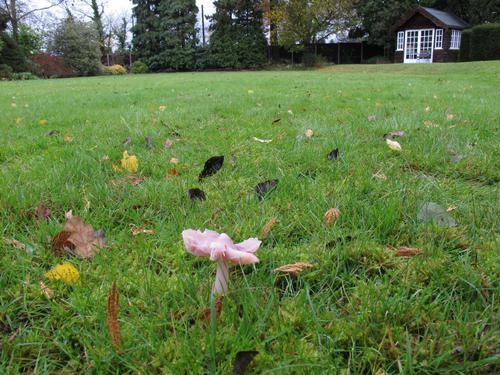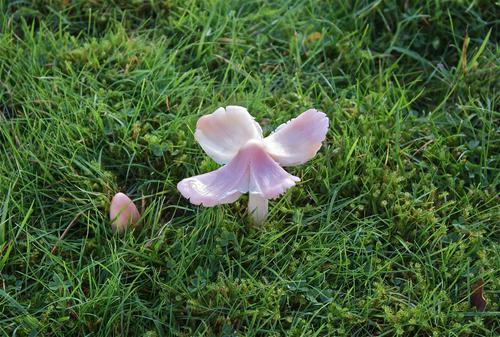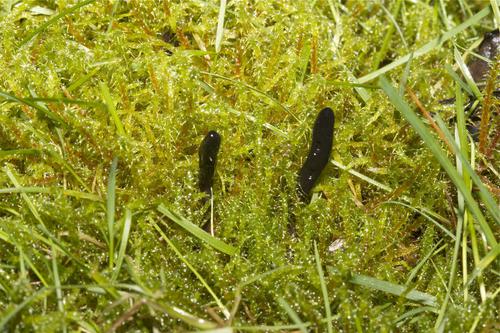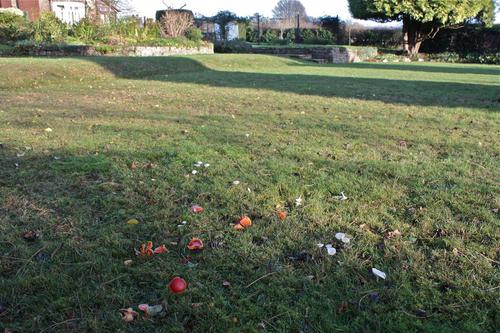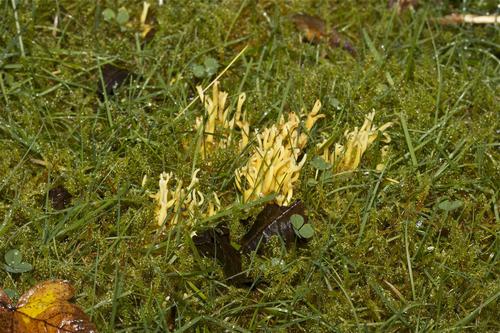Waxcap fungi near Stourbridge
Rosemary Winnall
When I give talks to wildlife groups I often show a picture of the Pink Waxcap fungus Hygrocybe calyptriformis and ask people to let me know if they spot it. I’ve been doing this for many years, but until recently no-one has ever been in contact.
However, in 2009 I was delighted when I had a phone call from David Elder who said he had seen this distinctive toadstool in a garden in Broome near Stourbridge. I made arrangements to visit the garden of Mr. David Taft on 30th November 2009 and as soon as I drove up the drive I could see the welcome sight of a lawn that was not the over-bright ‘improved’ green, but the distinctive yellow-green showing that there was plenty of moss present – a good sign!
I was shown round, and yes, there was plenty of the moss Rhytidiadelphus squarrosus that some waxcaps seen to be associated with. How good it was to find gardeners who did not use moss killer! I was thrilled to see several lawns in this lovely large garden, all dotted with brightly coloured fungi of various shades, shapes and sizes. What an unexpected delight to find this haven of meadow fungi so close to Stourbridge!
On that first visit I recorded the following:
Waxcaps
Hygrocybe calyptriformis (Pink or Ballerina Waxcap)
Hygrocybe virginea (Snowy Waxcap)
Hygrocybe coccinea (Scarlet Waxcap)
Hygrocybe pratensis (Meadow Waxcap)
Hygrocybe ceracea (Butter Waxcap)
Hygrocybe irrigata (Slimy Waxcap)
Hygrocybe psittacina (Parrot Waxcap)
Fairy clubs
Clavaria fragilis (White Spindles)
Clavulinopsis helvola (Yellow Club)
Clavulinopsis fusiformis (Golden Spindles)
Ramariopsis kunzei
Others
Laccaria laccata (The Deceiver)
Stropharia caerulea (Blue Roundhead)
Entoloma sp.
Galerina sp.
A return visit on 8th November 2010 resulted in the count of 18 fruiting bodies of Pink Waxcaps and some additions to the list, including:
Waxcaps
Hygrocybe chlorophana (Golden Waxcap)
Hygrocybe laeta var. laeta (Heath Waxcap)
Fairy clubs
Clavulinopsis corniculata (Meadow Coral)
Earth tongue
Geoglossum fallax
There will undoubtedly be other fungi species appearing in future years unless the management changes, and it will be most interesting to check this special garden in the future. It is an important Worcestershire site and might be of regional significance.
We often think of waxcap grasslands as being unimproved meadows, but we should not forget that churchyards and garden lawns can also yield good numbers of fungi if no nitrate fertiliser has been added and if they are cut regularly, the grass cuttings are removed and the moss left to grow naturally.
I am grateful to David Taft for permission to visit his delightful garden, and to David Elder who alerting me to its special nature. How good it is to see gardens managed with wildlife in mind! I wonder if there are any other Worcestershire gardens with Pink Waxcaps growing on the lawns?
Images
Fig. 1. Hygrocybe calyptriformis Pink or Ballerina Waxcap in lawn. Picture ©Rosemary Winnall
Fig. 2. Hygrocybe calyptriformis Pink or Ballerina Waxcap in lawn. Picture ©Rosemary Winnall
Fig. 3. Earthtongue Geoglossum fallax growing in mossy lawn. Picture ©Rosemary Winnall
Fig. 4. Waxcap lawn in Stourbridge. Picture ©Rosemary Winnall
Fig. 5. Clavulinopsis corniculatus Fairy Club Meadow Coral in lawn. Picture ©Rosemary Winnall
